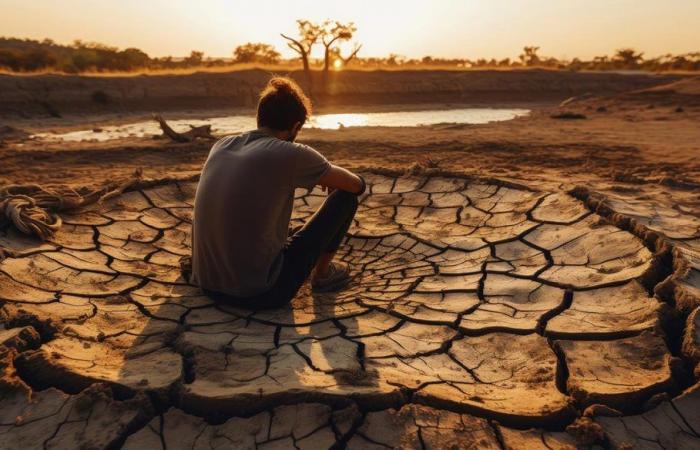Reading the figures of a research conducted by Human Highway for Assosalute makes you reflect how much and how the climatic conditions changed which we are observing weighs on our psyche and our well-being. Because if around four out of five Italians say they have heard of the issue, or in any case have wondered about it, 47% of those interviewed are convinced that, at present, climate change already has some serious consequences for everyone’s healthnot just vulnerable subjects.
Women are more attentive to the topic (84.2% vs 64.4% of men). But above all, on the age front, there is a real discrepancy between perception of phenomena and fears. If it is true that knowledge of the topic increases over the years, proving to be relatively lower among young people aged between 18 and 24 (68.6%) and very high among those over 65 (84%), it is undeniable that what happens to the climate tends to particularly worrying the very young, so much so that one in two fears health consequences linked to climatic vagaries. Adults, however, are less worried: in 45-54 year olds it doesn’t reach 40%.
More worried young people
“Young people – is the comment of the President Emeritus of SIMG (Italian Society of General Medicine and Primary Care), Claudio Cricelli – feeling personally involved in the current world and in the future, they are particularly attentive and concerned about the effects of climate change, even if this does not translate into fear for their personal health. On the contrary, older people feel the impact of environmental issues on their health already today, with evident symptoms. These two generations have, therefore, different perceptions and concerns: Young people project themselves into the future and want to act today to prevent problems for older people, while older people want immediate solutions to current problems.”
On the contrary, according to the expert, people between 45 and 65 are defined as “confused” because at the same time perpetrators and victims of the future consequences of their current decisions and choices. “They are in fact starting to experience the first ailments and health problems but, despite belonging to the class of decision-makers, they are not sure who will take care of their needs in the next 10-15 years, when they could start to get seriously ill”.
Viruses, allergies and more, how climate change affects health
Pollution, production and prolonged exposure to pollen, rising temperatures, floods and extreme weather conditions are all factors that influence and are influencing human health. 84.2% of Italians know this well, and recognize it in these the causes of minor ailments, in particular:
- widespread tiredness (common to 46.9% of the sample and especially among women (52.9% compared to 40.9% of men),
- musculoskeletal ailments due to temperature changes (33.2%),
- flu symptoms out of season (30%),
- prolonged allergies (29.1%).
If the older population is more affected by musculoskeletal disorders due to sudden changes in terms, young people are instead more susceptible to flus and allergies out of season. Not only are these symptoms very common, but they are also growing in recent years: 75% of people with widespread tiredness report a worsening compared to the past, while 60% observe an increase in ailments linked to temperature changesto out-of-season influences and to dehydration caused by sudden heat.
“There are many transformations we are witnessing that lead to consequences on health: the flowering of plants, for example, or the seasonality of pollen, with consequences on the allergy calendar, or, again, on that of epidemics – recalls the expert. Sometimes, peaks occur earlier, as happened this year with the flu, in December rather than January/February. In recent months and years we have observed peaks in acute respiratory illnesses, particularly evident in April, as occurred this year, and with symptoms persisting for a more prolonged period (2-3 weeks). All this makes us reflect on the existence of one correlation between climate and the trend of epidemicsa topic on which scientific research is already starting to provide some answers but which needs to be explored further.”
Risks to the respiratory tract
Although climate change is a global phenomenon, its impact varies according to different geographical situations, several “new” situations are occurring. Any examples? The flowering of plantsfor example, or the seasonality of pollen, with consequences on the calendar of allergies, or, again, on that of epidemics. Sometimes, peaks occur earlier, as happened this year with the flu, in December rather than January/February.
“In parallel, another phenomenon is emerging: in recent months and years we have observed peaks in acute respiratory diseases, particularly evident in April, as occurred this year, and with symptoms that persist for a more prolonged period (2-3 weeks) – points out Cricelli. It is important to understand the relationship between this change in the manifestation of infectious diseases and climate change. We suspect that there is a correlation and that land seasons are undergoing variations, also influencing the evolution of viruses”.
As if that wasn’t enough, thepollution concernto. And we’re not just talking about the atmospheric one.
“In metropolitan areas, like Milan for example, we have numerous studies that analyze pollution linked to car traffic, starting from the suburbs up to the center – recalls the expert. It has been shown that as concentrations of pollutants increase in urban areas and in the vicinity of other industrial plants, the risk of pollution-related diseases increases. Many municipalities, consequently, have adopted measures to reduce polluting emissions, based on consolidated data. Noise and light pollution should also not be underestimated, as they are emerging as an increasingly relevant problem; city noises, which pervade the streets both day and night, are actually a social practice with direct impacts on individual well-being”.
Chapter rest. “In the various areas of the historic centres, night sleep is disturbed due to social phenomena such as the presence of individuals on the street and the activity of nightclubs – says Cricelli. These factors inevitably cause discomfort and negatively affect the psychological balance of many people. The World Health Organization (WHO) has also reported an increase in psychological disorders, ranging from mild to severe, due to the constant stress caused by exposure to urban noise.”
What to do and who risks most
The rise in temperatures is now an indisputable phenomenon. And we need to be aware of it and prepare to face it longer seasons of heat appropriately, taking into account the different needs related to age and one’s initial clinical picture.
“The most vulnerable people should seek cool and shaded environments, avoiding exposure to the sun during the hottest hours and paying particular attention pay attention to nutrition and hydration – is Cricelli’s advice. Furthermore, especially in summer, it is necessary to pay attention to the drugs we take, especially those for cardiovascular problems, diuretics or for the central nervous system, as they can influence our response to heat and cold. It is important to consult your doctor for specific guidance on how to manage medications in relation to climatic variations. Furthermore, it is advisable to carefully monitor water intake, since with the heat and the consequent sweating a greater quantity of fluids is lost and must be replenished”.
Let’s be clear. Living beings are naturally predisposed to adapt to surrounding changes, but it is important to understand that every external stimulus elicits a reaction in us, and that there are limits to our ability to adapt. Although it is possible to live in extreme environments, such as arctic or equatorial environments, there is a point beyond which we lose control. Those who are most at risk may especially be those who do not have perfectly efficient regulation systems.
“In the past, 65-year-olds were considered elderly, but today this perception has changed. When we evaluate the impact on people’s health, 65-year-olds are no longer automatically labeled as elderly – comments Cricelli. Today’s 70-75 year olds have health problems that were typical of 65 year olds a few years ago. This phenomenon, therefore, does not only concern climate and environmental changes, but also the changes that occur within ourselves. However, young people are not exempt from the health consequences of climate change. Today, many of them ask questions about the future of the climate, but it is difficult to make predictions, the degree of accuracy of which depends on what we will do to improve the world in the next 40 years. Young people, feeling personally involved in the current and future world, are particularly attentive and concerned about the effects of climate change, but this does not translate into concern for their own health. In any case, the most vulnerable should seek cool, shaded environments, avoiding exposure to the sun during the hottest hours and paying particular attention to nutrition and hydration. It is fundamental for everyone Always stay hydrated and pay attention to medications that you take, consulting your doctor to obtain specific indications on how to manage the drugs in relation to climatic variations”.






